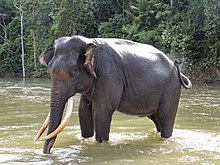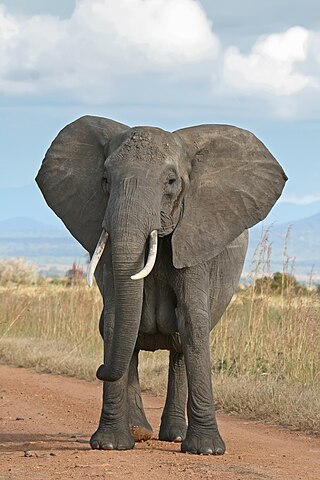
Elephants are the largest living land animals. Three living species are currently recognised: the African bush elephant, the African forest elephant, and the Asian elephant. They are the only surviving members of the family Elephantidae and the order Proboscidea; extinct relatives include mammoths and mastodons. Distinctive features of elephants include a long proboscis called a trunk, tusks, large ear flaps, pillar-like legs, and tough but sensitive grey skin. The trunk is prehensile, bringing food and water to the mouth and grasping objects. Tusks, which are derived from the incisor teeth, serve both as weapons and as tools for moving objects and digging. The large ear flaps assist in maintaining a constant body temperature as well as in communication. African elephants have larger ears and concave backs, whereas Asian elephants have smaller ears and convex or level backs.

Sumatra is one of the Sunda Islands of western Indonesia. It is the largest island that is fully within Indonesian territory, as well as the sixth-largest island in the world at 475,807.63 km2 (182,812 mi.2), including adjacent islands such as the Simeulue, Nias, Mentawai, Enggano, Riau Islands, Bangka Belitung and Krakatoa archipelago.
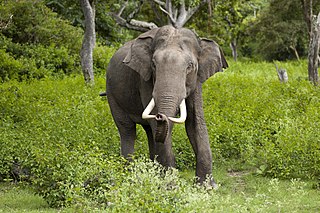
The Asian elephant, also known as the Asiatic elephant, is a species of elephant distributed throughout the Indian subcontinent and Southeast Asia, from India in the west, Nepal in the north, Sumatra in the south, and to Borneo in the east. Three subspecies are recognised—E. m. maximus, E. m. indicus and E. m. sumatranus. The Asian elephant is characterised by its long trunk with a single finger-like processing; large tusks in males; small ears folded laterally in contrast to African elephants; and wrinkled grey skin. The skin is smoother than African elephants and may be depigmented on the trunk, ears or neck. Adult males average 4 t in weight, and females 2.7 t.

Lampung, officially the Province of Lampung, is a province of Indonesia. It is located on the southern tip of the island of Sumatra. It has a short border with the province of Bengkulu to the northwest, and a longer border with the province of South Sumatra to the north, as well a maritime border with the province of Banten and Jakarta to the east. It is the original home of the Lampung people, who speak their own language, and possess their own written script. Its capital is Bandar Lampung.

The Sumatran tiger is a population of Panthera tigris sondaica on the Indonesian island of Sumatra. It is the only surviving tiger population in the Sunda Islands, where the Bali and Javan tigers are extinct.
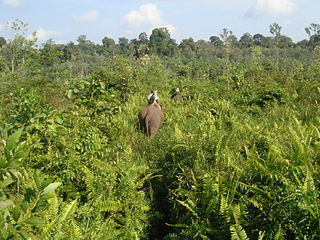
Tesso Nilo National Park is a national park in Riau Province, Sumatra, Indonesia. It was declared a national park by the Indonesian government in 2004. The original area of the park was 385.76 km2, but the decision has been made to expand it to 1000 km2. Tesso Nilo National Park houses some of the largest coherent lowland rainforests remaining on Sumatra. The Center for Biodiversity Management has surveyed over 1,800 plots in tropical forests around the world. They found that no other plot has as many vascular plants as in Tesso Nilo. Indonesian Institute of Sciences (LIPI) surveyed forests throughout Sumatra, and also found that Tesso Nilo housed by far the most species.

Gunung Leuser National Park is a national park covering 7,927 km2 in northern Sumatra, Indonesia, straddling the border of Aceh and North Sumatra provinces, a fourth portion and three-fourths portion, respectively. The national park, settled in the Barisan mountain range, is named after Mount Leuser (3,119 m), and protects a wide range of ecosystems. An orangutan sanctuary at Bukit Lawang is located within the park. Together with Bukit Barisan Selatan and Kerinci Seblat National Parks, it forms a World Heritage Site, the Tropical Rainforest Heritage of Sumatra.

The Sumatran orangutan is one of the three species of orangutans. Critically endangered, and found only in the north of the Indonesian island of Sumatra, it is rarer than the Bornean orangutan but more common than the recently identified Tapanuli orangutan, also found in Sumatra. Its common name is based on two separate local words, "orang" and "hutan" ("forest"), derived from Malay, and translates as 'person of the forest'.

Way Kambas National Park is a national park covering 1,300 km2 (500 sq mi) in Lampung province of southern Sumatra, Indonesia. It consists of swamp forest and lowland rain forest, mostly of secondary growth as result of extensive logging in the 1960s and 1970s. Despite decreasing populations, the park still has a few critically endangered Sumatran tigers, Sumatran elephants and Sumatran rhinoceroses. It also hosts over 400 bird species.

The Sri Lankan elephant is native to Sri Lanka and one of three recognised subspecies of the Asian elephant. It is the type subspecies of the Asian elephant and was first described by Carl Linnaeus under the binomial Elephas maximus in 1758. The Sri Lankan elephant population is now largely restricted to the dry zone in the north, east and southeast of Sri Lanka. Elephants are present in Udawalawe National Park, Yala National Park, Lunugamvehera National Park, Wilpattu National Park and Minneriya National Park but also live outside protected areas. It is estimated that Sri Lanka has the highest density of elephants in Asia. Human-elephant conflict is increasing due to conversion of elephant habitat to settlements and permanent cultivation.

The Indian elephant is one of three extant recognized subspecies of the Asian elephant, native to mainland Asia. The species is smaller than the African elephant species with a convex back and the highest body point on its head. The species exhibits significant sexual dimorphism with a male reaching an average shoulder height of about 3.2 m (10 ft) and weighing up to 5,400 kg (11,900 lb) whereas a female reaches an average shoulder height of about 2.54 m (8.3 ft) and weighs up to 4,160 kg (9,170 lb). It has a broader skull with a concave forehead, two large laterally folded ears and a large trunk. It has grey colored smooth skin with four large legs and a long tail.

The Borneo elephant, also called the Bornean elephant or the Borneo pygmy elephant, is a subspecies of Asian elephant (Elephas maximus) that inhabits northeastern Borneo, in Indonesia and Malaysia. Its origin remains the subject of debate. A definitive subspecific classification as Elephas maximus borneensis awaits a detailed range-wide morphometric and genetic study. Since 1986, the Asian elephant has been listed as Endangered on the IUCN Red List as the population has declined by at least 50% over the last three generations, estimated to be 60–75 years. It is pre-eminently threatened by loss, degradation and fragmentation of habitat.
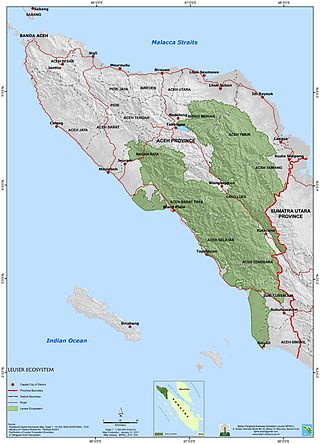
The Leuser Ecosystem is an area of forest located in the provinces of Aceh and North Sumatra on the island of Sumatra in Indonesia. Covering more than 2.6 million hectares it is one of the richest expanses of tropical rain forest in Southeast Asia and is the last place on earth where the Sumatran elephant, rhino, tiger and orangutan are found within one area. It has one of the world's richest yet least-known forest systems, and its vegetation is an important source of Earth's oxygen. Leuser also possesses more lowland rainforest than the rest of Sumatra combined and supports some of the last viable populations of tiger, rhino, orangutan and elephant.

Bukit Tigapuluh National Park - The Thirty Hills - is a 143,223-hectare National Park in eastern Sumatra, consisting primarily of tropical lowland forest, largely in Riau province, with a smaller part of 33,000 ha in Jambi province. It is famous as one of the last refuges of endangered species such as the Sumatran orangutan, Sumatran tiger, Sumatran elephant, and Asian tapir, as well as many endangered bird species. It forms part of the Tesso Nilo Complex biodiversity hotspot. The Park is inhabited by the indigenous peoples of the Orang Rimba and Talang Mamak tribes.

The Indonesian island of Sumatra is the sixth largest island in the world. The rich ethnic diversity and historical heritage in Sumatra is reflected in the range of architectural styles in the island. The vernacular style is the native Sumatran ethnic groups architecture of dwellings, while the Hindu-Buddhist architecture reflected through the cultural historical heritage of candis built in Sumatra. The third wave is Islamic architecture adopted in mosques and palace in Sumatra, especially in Aceh, North Sumatra, and Malay cultural sphere in the island.

The Javan elephant was proposed by Paules Edward Pieris Deraniyagala in 1953, based on an illustration of a carving on the Buddhist monument of Borobudur in Java. He thought that the Asian elephant had indeed existed on the island and had gone extinct. It may be considered synonymous with the Sumatran elephant.

Giam Siak Kecil-Bukit Batu Bioreserve is a peatland area in Riau Province of Sumatra, covering 705,271 hectares (2,723.07 sq mi) and large parts of Bengkalis Regency and Siak Regency. It is a declared UNESCO Man and the Biosphere Reserve and supports a sustainable timber industry. It is home to two wildlife reserves, namely Giam Siak Wildlife Reserve and Bukit Batu Wildlife Reserve; flagship species include the Sumatran elephant and Sumatran tiger.

The Sumatran freshwater swamp forests ecoregion covers disconnected patches of freshwater swamp forest on the alluvial plains of the island of Sumatra in Indonesia. The different locations vary greatly in their vegetation and wildlife habitat depending on the local soil types. The land has been greatly disturbed by human conversion to agriculture and illegal logging in recent years. Several of the sectors support significant populations of Asian elephants (Elephas maximus)'.
